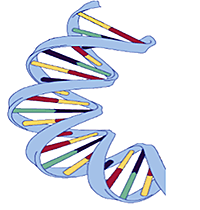
Extracting DNA from a Banana and Other Fruits
Introduction
All living things, bananas and people included, pass on information from one generation to the next using the same basic material, DNA. Within every living organism, most cells contain a complete set of DNA instructions. The information in DNA tells our bodies how to develop, grow, and work. It also controls many of the features that make an organism unique.

These instructions are in segments of DNA called genes. Genes, along with other parts of our DNA that turn genes on and off, hold information for how our body develops and functions. They produce molecules called proteins that do most of the work in the body. Variants of genes, called alleles, are responsible for differences in hair color, eye color, and earlobe shape.
All of these instructions fit within tiny packages within our tiny cells, so that is all way too tiny for anyone to ever really see or touch, right? Well, not entirely. Because DNA is in every cell, there is a lot of it in an organism. If you took all of the DNA out of some middle-sized organism (or part of an organism, like a piece of fruit), you could see and even touch DNA. We will use common household products to break apart the cells in a banana and extract out the DNA. While you may know of the double-helix structure of DNA, you can't see that structure with the naked eye. So when seeing it without a high-powered microscope...what does DNA look like?
Materials

- 1/2 peeled ripe banana (you can also use strawberries or other fruit)
- 1/2 cup hot water
- 1 tsp salt
- 1/2 tsp liquid dishwashing soap
- resealable zip-top bag (quart size)
- very cold rubbing alcohol (isopropyl alcohol) placed in freezer ahead of time
- coffee filter
- narrow glass
- wooden stirrer
Watch biologist Melissa Wilson Sayres as she shows you step-by-step how to extract DNA from a banana.

Extracting DNA in 10 Easy Steps
- Mush the banana in the resealable bag for about a minute until all the lumps are gone and it almost looks like pudding.
- Fill a cup with the hot water and salt.
- Pour the saltwater mix into the bag. Close the bag and very gently squeeze and move the saltwater and banana mush together. Do this for 30 to 45 seconds.
- Add the dishwashing soap into the bag and gently mix the contents. Try to avoid making too much foam.
- Place the coffee filter in a clear glass cup, securing the top of the filter around the lip of the cup.
- Pour the mix into the filter and let it sit until all of the liquid drips down into the cup.
- Remove and discard the used coffee filter.
- Tilt the glass and slowly add cold alcohol down the side of the cup. You want the alcohol to form a layer on top of the banana mix, staying separated, so be careful not to pour it too fast. Make a layer of alcohol that is 2.5-5cm (1-2in) thick.
- After the alcohol layer is set up, wait for eight minutes. You may see some bubbles and cloudy material moving around in the alcohol. This is the DNA pieces clumping together.
- Use the wooden stirrer to start poking the cloudy stuff in the alcohol layer. Spin the stirrer it in place to start gathering the cloudy stuff. When you are done, take a closer look at the stuff on the stirrer. You are looking at DNA!
(Teacher & student packet is available.)

What Happened?
You may understand that mashing a banana can break cells apart and help break apart cell walls, but why was all that other stuff added? And how did we get inside the cells and get the DNA to stick together?
Let's think of three of the main items we added to the bananas.
- Saltwater - The bananas were mashed with saltwater before anything else was added. But this was a special step preparing for the addition of the dish soap. Once the dish soap helps release the DNA, this salt will help the DNA strands to stick to each other in clumps large enough for you to see.
- Dish soap - Dish soap can help split apart the membranes (the outer "skin") that hold cells together. These membranes are made of a type of molecule called lipids. When you think of lipids, think of fats and oils. Dish soap "cuts through grease" because it actually separates those greasy molecules from each other. Now, the molecules that make the membranes around cells and the nucleus (which holds DNA) are lipids. So when dish soap is added, the cell membrane and the nuclei are broken apart, releasing the DNA.
- Alcohol - The DNA clumps are soluble (can be dissolved) in some liquids, but not in alcohol. So adding alcohol helps the clumps of DNA to form.
Credits
Banana and Strawberry image by Ralph Daily via Wikimedia Commons.
Read more about: Seeing DNA
Bibliographic details:
- Article: Seeing DNA
- Author(s): Melissa Wilson Sayres
- Publisher: Arizona State University School of Life Sciences Ask A Biologist
- Site name: ASU - Ask A Biologist
- Date published:
- Date accessed:
- Link: https://askabiologist.asu.edu/activities/banana-dna
APA Style
Melissa Wilson Sayres. (). Seeing DNA. ASU - Ask A Biologist. Retrieved from https://askabiologist.asu.edu/activities/banana-dna
Chicago Manual of Style
Melissa Wilson Sayres. "Seeing DNA". ASU - Ask A Biologist. . https://askabiologist.asu.edu/activities/banana-dna
Melissa Wilson Sayres. "Seeing DNA". ASU - Ask A Biologist. . ASU - Ask A Biologist, Web. https://askabiologist.asu.edu/activities/banana-dna
MLA 2017 Style

DNA is in every living thing (and it's only in living things).
To extract DNA for this activity, it is best to use mushy fruit. Bananas and strawberries are great choices.
Download the -
Banana DNA activity (PDF)
Learn more about Melissa Wilson Sayres' work with Monster DNA.
Be Part of
Ask A Biologist
By volunteering, or simply sending us feedback on the site. Scientists, teachers, writers, illustrators, and translators are all important to the program. If you are interested in helping with the website we have a Volunteers page to get the process started.

